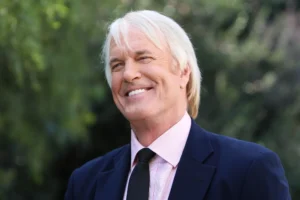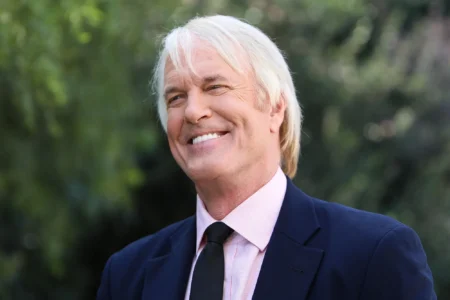The removal of the Black Lives Matter (BLM) mural in Washington, D.C., has ignited a firestorm of emotions, particularly from those who have experienced firsthand the painful struggle for justice in the Black community. Among the voices of dissent is Wanda Cooper Jones, the mother of Ahmaud Arbery, whose tragic death became a significant rallying point for the Black Lives Matter movement. For Jones, the decision to remove the mural is not just a symbolic gesture—it’s a powerful reminder of the fragility of progress, especially in a society that has witnessed too many setbacks.
Jones spoke exclusively with TMZ, expressing deep concern over the move, stating that the removal of the BLM mural “feels like a bad omen.” She explained that the action symbolizes a broader issue—the precarious nature of any advancements made in the fight for racial equality. “It’s a reminder of how fragile progress can be,” said Jones, reflecting the sentiment shared by many who have fought for justice in the aftermath of the countless Black lives lost to systemic violence.
In her conversation, Jones emphasized that the Black Lives Matter movement has always been about more than just murals, monuments, or symbolic displays. At its core, BLM has been a call for accountability, justice, and real, meaningful change. Yet, the removal of the mural, which had been painted on the streets of D.C. as a direct response to the widespread outcry following the murder of George Floyd, is seen by many as an erasure of history and a step backward in the nation’s progress toward addressing racial injustice.
For Jones, the BLM mural in D.C. symbolized the fight for justice—not just for George Floyd but for the countless others whose lives were unjustly taken due to systemic racism. She was particularly vocal in her concern that removing the mural was not merely a political gesture but an emotional one. It signaled to her that the nation had become complacent, willing to erase the very symbols that had come to represent the ongoing struggle for justice and reform. “It’s not about the mural itself,” she said, “it’s about what it represents.”
The Black Lives Matter movement was catapulted into the global spotlight after the horrific murder of George Floyd in May 2020, which was followed by protests across the world. However, as Jones points out, the movement’s roots go much deeper. It was ignited by the brutal murder of Trayvon Martin in 2012, and the subsequent killing of Michael Brown in 2014. Over time, it has grown to represent the voices of countless Black individuals whose lives were cut short by violence and discrimination.
The death of her son, Ahmaud Arbery, who was shot and killed in February 2020 while out for a jog in Glynn County, Georgia, also became a pivotal moment in the larger narrative of racial injustice. Arbery’s murder, captured on video and widely shared on social media, sparked nationwide outrage and became a rallying cry for the movement. The three white men responsible for Arbery’s death were eventually convicted, but the fight for justice did not stop there.
Jones noted that while the removal of the BLM mural may feel like a step backward, it should serve as a stark reminder of the need to stay vigilant in the fight for justice. She emphasized that real progress comes not from symbolic gestures but from tangible changes in laws, policies, and attitudes. “It’s never been about the murals or monuments,” she asserted. “It’s about the laws and accountability.”
Her sentiments are echoed by Lee Merritt, an attorney who has represented the families of several victims of police violence, including Arbery, Floyd, and Breonna Taylor. Merritt, who has been at the forefront of legal efforts to hold those responsible for these deaths accountable, pointed out that justice is not measured in murals but in legal actions and policy reforms. “Justice isn’t measured in murals,” Merritt said. “It’s measured in laws, accountability, and protecting Black lives.”
Indeed, while the mural’s removal is a painful reminder of the setbacks Black Americans face, it does not erase the significant strides made in recent years. The murderers of Ahmaud Arbery were sentenced to life in prison, and the passage of the Ahmaud Arbery Hate Crimes Act marked an important step toward holding individuals accountable for racially motivated violence. Additionally, Georgia’s repeal of the vigilante defense law used by Arbery’s killers to justify their actions stands as a testament to the power of grassroots activism and the need for systemic change.
Despite these victories, the removal of the BLM mural underscores the continued challenges the Black community faces in achieving lasting change. It serves as a stark reminder that while progress may have been made, there is still much work to be done. As Jones pointed out, the fight for justice and equality is ongoing, and it is essential that the nation not lose sight of the principles that the Black Lives Matter movement was founded upon.
As for the future of the movement, Jones remains hopeful that the removal of the mural will not dampen the spirit of activism that has been sparked across the country. “We can’t allow these setbacks to define us,” she said. “We have to keep pushing for real change, and we have to keep fighting for justice.”
The BLM mural may have been removed, but the fight for justice continues—more urgent and necessary than ever. The Black Lives Matter movement has proven to be more than a moment—it is a movement, a call for accountability, and a demand for lasting change. As Wanda Cooper Jones and so many others have shown, the journey toward justice is long and difficult, but it is a journey that cannot and should not be forgotten.
In the face of adversity, the strength and resilience of the Black community will continue to rise, pushing for progress, demanding accountability, and ensuring that the voices of those who have been silenced are heard.








